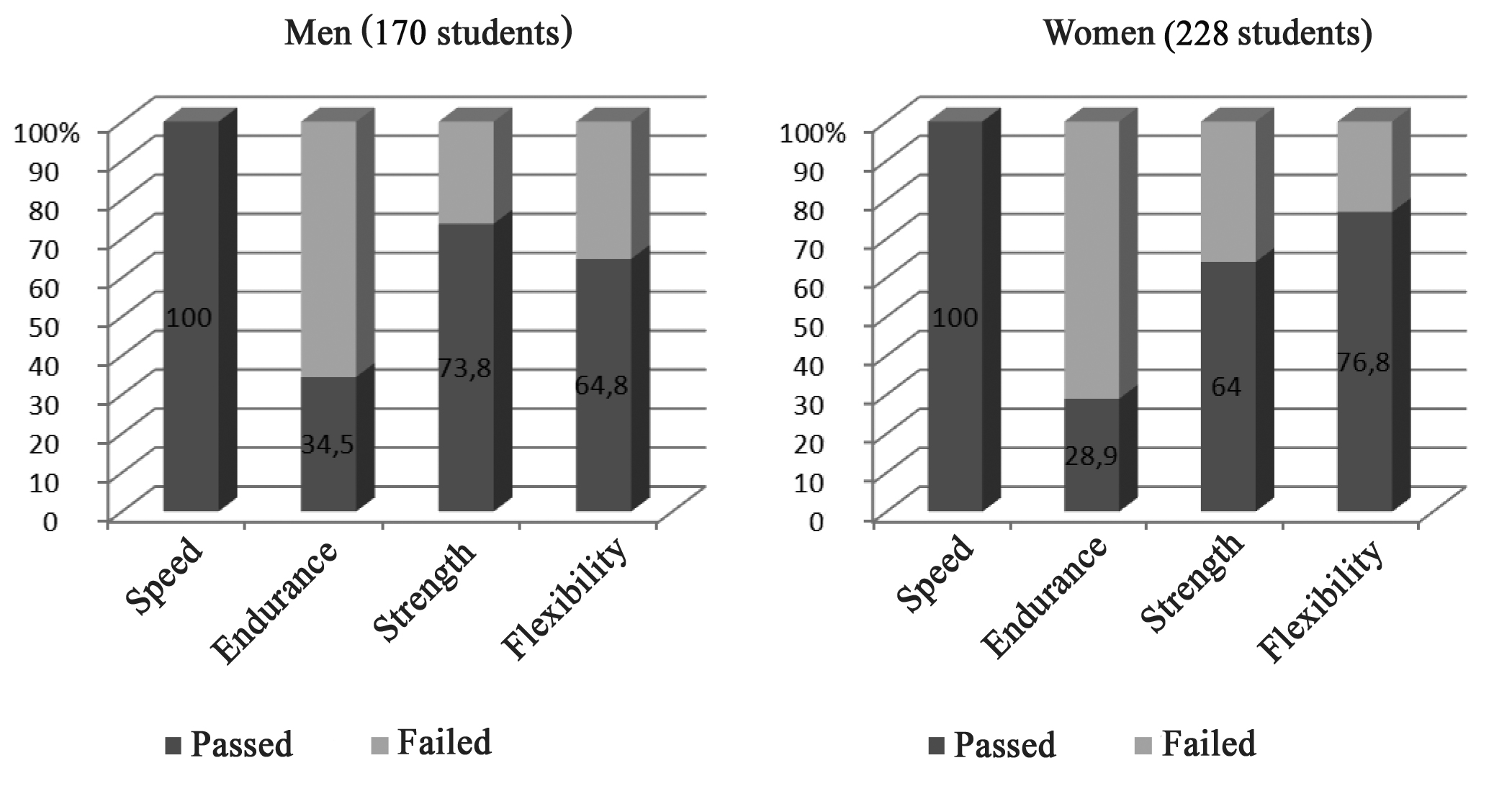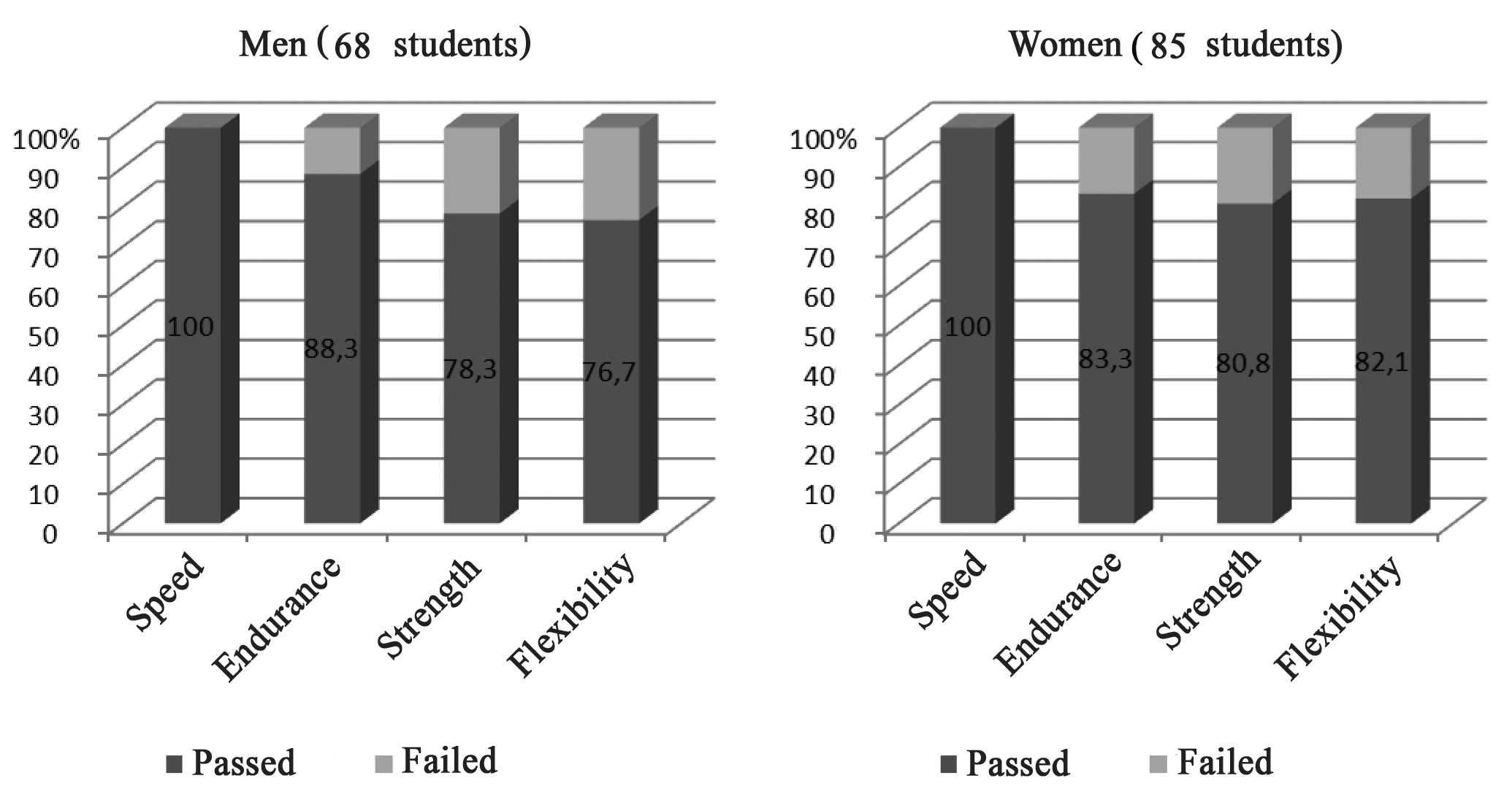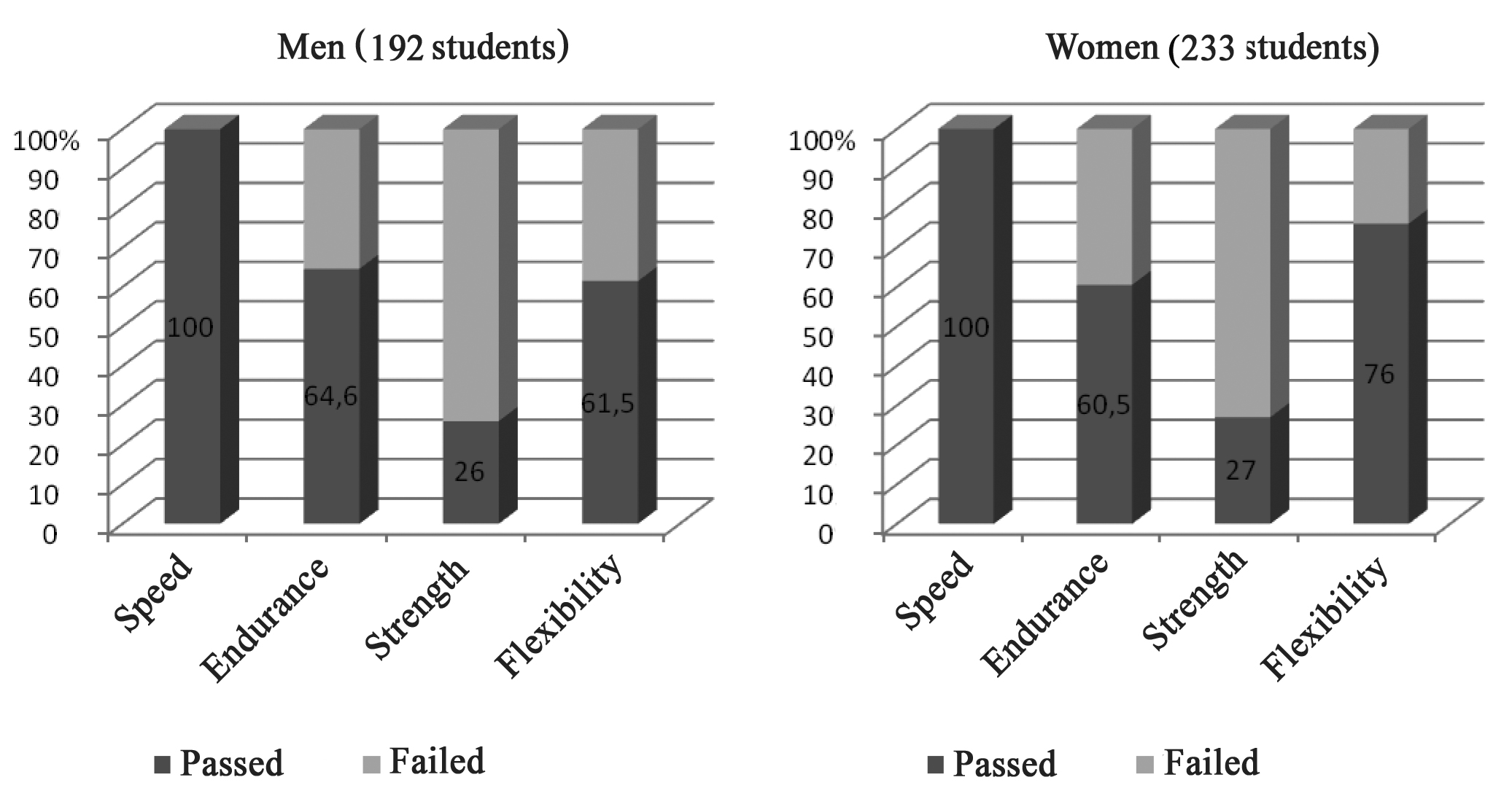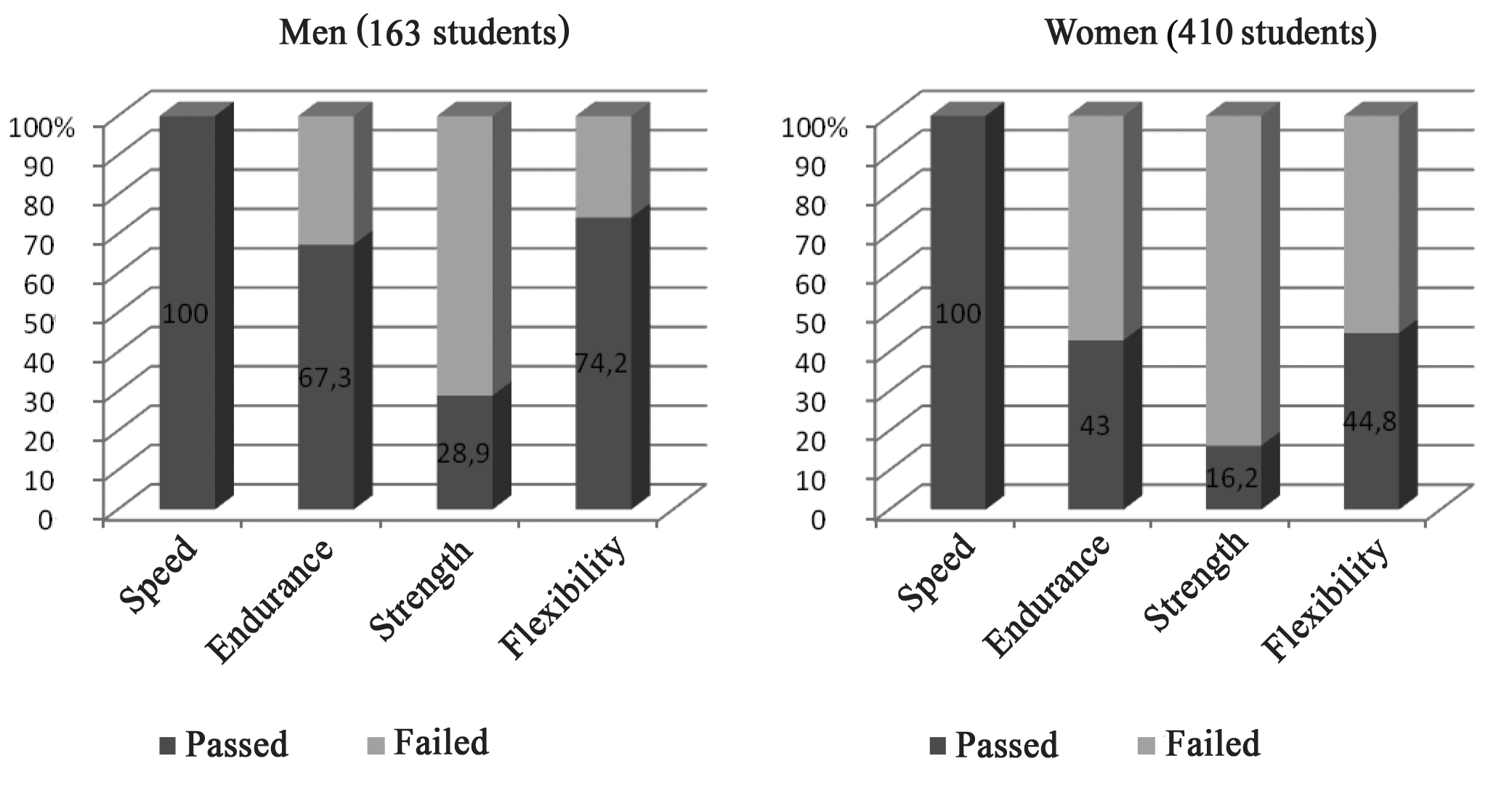Rating university students' fitness for GTO complex tests
Фотографии:
ˑ:
PhD, Associate Professor A.V. Voronkov1
PhD, Associate Professor I.N. Nikulin1
PhD A.V. Posokhov1
M.S. Koreneva1
1Belgorod State National Research University, Belgorod
Keywords: GTO Complex, physical fitness, tests.
Background. Presently the Russian Physical Culture and Sports “Ready for Labour and Defence” (GTO) Complex is viewed as a systemic component of the programmatic and regulatory framework of the national physical education with the relevant physical fitness standards for every age group [1, 3]. In the context of the growing popularity of the GTO Complex, the national physical culture and sports sector community needs to develop an age-specific physical fitness rating system that, in its turn, will support the efforts to establish due theoretical grounds for the relevant age-specific training systems to make the trainees fit for the tests [4].
Furthermore, the physical fitness monitoring and the GTO badge qualification test data may be helpful for the initiatives to design the academic physical education systems. Many researchers have noted that most challenging for the students are normally the obligatory tests, whilst their success rates in the optional tests may often come to 100% [2]. Therefore, there are good grounds to assume that the physical training process for the obligatory GTO badge qualification tests is to be designed to give a high priority to the obligatory tests focused practices.
Objective of the study was to obtain and analyse the students’ physical fitness rates for the obligatory GTO tests.
Methods and structure of the study. To rate the students fitness for the obligatory GTO badge qualification tests, we analysed the test rates of the Belgorod State National Research University students as of the first semester of 2016-17 academic year. Subject to the tests were 936 students including 608 young women and 328 young men.
Study results and discussion. As demonstrated by Table 1, most challenging for the students of the both genders is the standing bends forward on a gymnastic bench test albeit 80% of the students tested by the GTO Complex tests were successful in this test; and 20% and 39% of the male and female students (respectively) failing even in the GTO Bronze Badge tests.
The 100 m sprint test was successful for 67% male and 57% female students, with 18% male and 34% female students failing the test.
The strength tests under the GTO Complex are optional and gender-specific, with young men being optionally tested by the pull-up or 16-kg kettlebell snatch tests. As seen from Table 1, 97% of the male subjects were successful in the kettlebell snatch test. Of the female students, only 33% were successful in the push-up test.
Table 1. Success rates in the obligatory GTO Complex tests for the Belgorod State National Research University students as of the first semester of the academic year of 2016-17
|
Test |
Sex |
Tested people and share of the total test sample, % |
Gold winners and share of the tested total, % |
Silver winners and share of the tested total, % |
Bronze winners and share of the tested total, % |
Failed, people and share of the tested total, %
|
|
100m sprint
|
M |
206 (62,8%) |
100 (48,5%) |
63 (30,6%) |
7 (3,4%) |
36 (17,5%) |
|
F |
345 (56,7%) |
110 (31,9%) |
77 (22,3%) |
41 (11,9%) |
117 (33,9%) |
|
|
2/3km race
|
M |
96 (29,3%) |
41 (42,7%) |
22 (22,9%) |
5 (5,2%) |
28 (29,2%) |
|
F |
143 (23,5%) |
42 (29,4%) |
35 (24,5%) |
8 (5,5%) |
58 (40,6%) |
|
|
Bends forward
|
M |
266 (81,1%) |
76 (28,6%) |
73 (27,4%) |
14 (5,3%) |
103 (38,7%) |
|
F |
510 (83,9%) |
178 (34,9%) |
155 (30,4%) |
77 (15,1%) |
100 (19,6%) |
|
|
Pull-ups
|
M |
205 (62,5%) |
78 (38%) |
44 (21,5%) |
23 (11,2%) |
60 (29,3%) |
|
F |
344 (56,6%) |
93 (27%) |
67 (19,5%) |
57 (16,6%) |
127 (36,9%) |
|
|
16kg kettlebell snatch |
M |
105 (32,0%) |
86 (81,9%) |
9 (8,6%) |
7 (6,7%) |
3 (2,8%) |
|
Push-ups |
F |
207 (34,0%) |
41 (19,8%) |
18 (8,7%) |
9 (4,3%) |
139 (67,2%) |
It is the endurance 2/3km race test that was the most challenging both for males and females, with only 30% and 24% of the male and female students (respectively) taking this test; and with 30% and 41% of the latter, respectively, failing even in the GTO Bronze Badge test. In view of the fact that one need to stand every obligatory test to qualify for either GTO Badge, it should be mentioned that the endurance race test effectively screens out many candidates so that only up to 20% and 10% of the male and female students (respectively) could qualify for the badges. Therefore, in the academic physical education system designs a special emphasis is to be made to the overall endurance building practices.
It should also be mentioned that only 77 and 100 male and female students, respectively (making 23% and 16% of the total pool of candidates), ventured to take all the obligatory tests. Given in Table 2 hereunder are the test success rates of these students.
Table 2. GTO Complex test success rates of the students who opted for all the obligatory tests
|
Sex |
Total number
|
Stood every obligatory test, people/ % |
Failed in the 100m sprint, people/ % |
Failed in the 2/3km race, people/ % |
Failed in the strength test, people/ % |
Failed in the flexibility test, people/ % |
|
М |
77 |
38 / 49,4% |
3 / 3,9% |
19 / 24,7% |
12 / 15,6% |
18 / 23,4% |
|
F |
100 |
49 / 49% |
20 / 20% |
47 / 47% |
20 / 20% |
10 / 10% |
As seen from Table 2, only 50% of the students who opted for all the obligatory tests were successful in each of them. It should be noted that the endurance and flexibility tests were the most challenging for the young men (25% and 23% failed, respectively); and of the candidate young women, 47% failed in the endurance test and 20% were unable to stand the speed and strength tests.
It is now clear that the students’ training process for the GTO Complex tests should be designed on an individualised basis. Depending on the individual success rates in the tests, all the subjects were split up into the following four groups.
Group 1 was made of those who succeeded in the 100m sprint test for whatever badge. As demonstrated by Figure 1, 65% and 71% of the male and female students (respectively) who succeeded in the 100m sprint test – still failed in the 2/3km race test. Furthermore, the standing bends forward on a gymnastic bench test was failed by 35% and 23% of the male and female students (respectively); and 26% and 36% of the male and female students (respectively) failed in the strength test.

Figure 1. Test success rates of the students who succeeded in the 100m sprint test
Group 2 was composed of those who succeeded in the 2/3km race test for whatever badge (Figure 2). Most challenging for the group males were the flexibility and strength tests (23% and 22% failed, respectively) and for the group females – the strength tests (19% failed).

Figure 2. Test success rates of the students who succeeded in the 2/3km (women/ men) race test

Figure 3. Test success rates of the students who succeeded in the strength test
Group 3 was composed of those who succeeded in the strength test for whatever badge. As seen from Figure 3, the endurance test was the most challenging for this group (with some 74% and 73% of male and female students, respectively, failed in the 2/3km races for a badge). Furthermore, 38% and 24% of the male and female students (respectively) of this group failed in the standing bends forward test; and 35% and 39% male and female students (respectively) of the group failed in the 100m sprint test.

Figure 4. Test success rates of the students who succeeded in the standing bends forward on a gymnastic bench test
Group 4 was made of those who succeeded in the flexibility test for whatever badge: see Figure 4. Most challenging for this group was the endurance race test, with 71% and 83% of the group male and female students (respectively) failed in the race. Furthermore, 33% and 57% of the male and female students (respectively) of this group failed in the 100m sprint test; and 26% and 55% of the male and female students (respectively) of this group failed in the strength tests.
Conclusion. The study data and analysis showed the need for an individualized training approach to improve the efficiency of the students’ training for the GTO Complex tests within the frame of the academic elective physical education disciplines and self-training process.
The academic training process content and priorities to make the students fit for the GTO Complex tests are to be customized to develop certain physical qualities. The students tested with dominating speed and strength abilities and flexibility are recommended to assign up to 50% of the training time to the general endurance building practices. The students leading in the 2/3 km races are recommended to give virtually the same priorities to the endurance-, speed-, strength- and flexibility-building practices.
References
- Ikhsanov I.S., Aydarov R.A. Rezultaty monitoringa gotovnosti studentov vuza k vypolneniyu obyazatelnykh testov kompleksa GTO (po itogam provedeniya osennkh ispytaniy 2015 g.) [Results of monitoring of students' fitness for mandatory GTO complex tests (based on the results of autumn 2015 tests)]. Uchenye zapiski un-ta im. P.F. Lesgafta, 2015, vol. 132, no. 2, pp. 83-87.
- Nikulin I.N., Voronkov A.V., Posokhov A.V., Revina J.A. Monitoring urovnya fizicheskoy podgotovlennosti studentov vuza pri vypolnenii ispytaniy kompleksa GTO [Students' fitness level monitoring during GTO complex tests]. Kultura fizicheskaya i zdorovye, 2016, no. 5 (60), pp. 88-90.
- Polukhin O.N., Irkhin V.N., Nikulin I.N., Nikulina T.V. Organizatsiya zdorovyeorientirovannoy deyatelnosti Belgorodskogo gosudarstvennogo natsionalnogo issledovatelskogo universiteta: rezultaty i perspektivy [Organization of health activities in Belgorod State National Research University: results and prospects]. Mater. Vseros. nauch.-prakt. konf. "Aktualnye problemy vnedreniya kompleksa GTO i razvitiya massovogo sporta" [Proc. Rus. res.-pract. conf. "Actual problems of introduction of GTO complex and development of mass sports"]. NRU BSU. Belgorod: «Belgorod» NRU BSU publ., 2016, pp. 11-15.
- Rakhmatov A.I., Vasenin G.A., Mashoshina I.V. Monitoring vypolneniya norm Vserossiyskogo fizkulturno-sportivnogo kompleksa GTO shkolnikami i studentami g. Moskvy [Monitoring of fulfillment of the standards of Russian Physical Culture and Sports GTO Complex by Moscow schoolchildren and students]. Mater. Vseros. nauch.-prakt. konf. "Aktualnye problemy vnedreniya kompleksa GTO i razvitiya massovogo sporta". [Proc. Rus. res.-pract. conf. "Actual problems of introduction of GTO complex and development of mass sports"]. NRU BSU. Belgorod: «Belgorod» NRU BSU publ., 2016, pp. 186-192.
Corresponding author: Voronkov@bsu.edu.ru
Abstract
Subject to the study was the Belgorod State National Research University students' fitness for the obligatory GTO Complex tests. The study identified the least- and most-challenging tests for the students, with the sample broken down into four groups depending on the obligatory GTO Complex test results. The study data and analysis showed the need for an individualized training approach to improve the efficiency of the students’ training for the GTO Complex tests by means of the academic elective physical education disciplines and self-training process.
The academic training process content and priorities to make the students fit for the GTO Complex tests is to be customized to develop certain physical qualities. The students tested with dominating speed and strength abilities and flexibility are recommended to assign up to 50% of the training time to the general endurance building practices. The students leading in the 2/3 km races are recommended to give virtually the same priority to the endurance-, speed-, strength- and flexibility-building practices.



